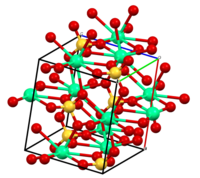
Photo from wikipedia
Zinc phosphate cement is used in dentistry to lute crowns and bridges. So far, its biocompatibility for other applications has not been studied. This paper reports the biocompatibility of zinc… Click to show full abstract
Zinc phosphate cement is used in dentistry to lute crowns and bridges. So far, its biocompatibility for other applications has not been studied. This paper reports the biocompatibility of zinc phosphate towards MG63 cells, testing both the material (discs; 3 mm diameter × 1 mm thick) and leachate from the cement. Cell viability was determined using an MTT assay, and cytotoxicity from the effects of leachate, studied in triplicate. Microscopy (optical and scanning electron) determined the morphology and proliferation of cells attached to zinc phosphate. ICP-OES measured element release into leachate, and anti-microbial behaviour was determined against Streptococcus pyrogenes cultured on a Brain Heart Infusion agar using cement discs (3 mm diameter × 1 mm thick). Zones of inhibition were measured after 72 h. MG63 cells proliferated on zinc phosphate surfaces and retained their morphology. The cells were healthy and viable as shown by an MTT assay, both on cement and in leachate. High levels of phosphorus but low levels of zinc were released into leachate. The cement showed minimal antimicrobial activity against S. pyogenes, probably due to the long maturation times used. Zinc phosphate cement was found to be biocompatible towards MG63 cells, which indicates that it may be capable of use in bone contact applications.
Journal Title: Biomedicines
Year Published: 2023
Link to full text (if available)
Share on Social Media: Sign Up to like & get
recommendations!